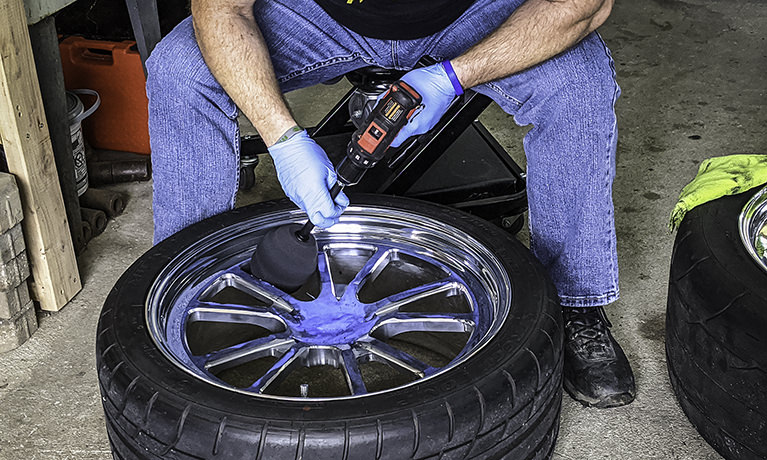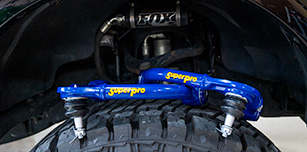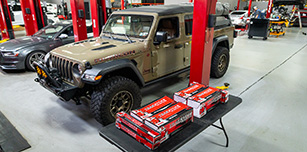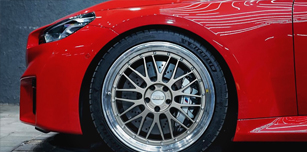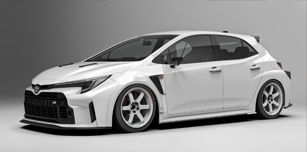Today’s wrap-up of DIY Week includes several articles that are based on appearance; from ceramic coating to wheel polishing, these show you techniques to maintain your pride and joy. With so much downtime for those who are sitting at home due to the Coronavirus pandemic, what better time than the present to get into the garage and get working on those projects you’ve been putting off for so long?
We’ve also been in the garage working on our projects, and that process spurred us to think about some of the other unique and exciting DIY articles we’ve presented over the years. Within each article, you’ll find many tips and tricks to help you complete the processes—hopefully with a successful outcome—and allow you to maintain your vehicle’s appearance to your satisfaction.
Does 3M Paint Defender Spray Film Really Work?



We’ve all seen the guy who shows up to the track event with the front end of his car covered in blue painter’s tape or has the rear quarter panels covered at the dragstrip with the same. I know, because I have been that guy. Cleaning burnout goo from the quarter panels of a car is never fun, and it’s often not easy to remove no matter what chemical you use to melt the rubber, not to mention the potential for damaged paint in the process. Similarly, the potential injuries incurred to a vehicle’s body panels in other forms of racing are equally saddening. Thankfully, there are options.
In our DIY installation and test of 3M’s Paint Defender film, author Scott Tsuneishi explores the differences between a traditional transparent adhesive paint-protection film and the unique spray-on film manufactured by the chemical wizards at 3M. To thoroughly test the Paint Defender’s abilities, Scott enlisted the Rally American National Championship Scion xD for testing to see if the removable spray-on film would work well in a harsh environment. Rally racing puts the car’s body panels in harm’s way; bumps and bruises on a rally course are caused by many factors, including flying rocks and other road-going debris. He also did some impromptu testing on spare materials he had in the garage, then abused them using a media blaster, with surprising results. Click through to the article for more details—the results will surely be of interest.
The Truth About Ceramic Coatings: Protection That’s More Than A Wax



As one of the judges for the Japanese Classic Car Show, Scott Tsuneishi has more than a passing interest in vehicle appearance, and several of the articles he’s written for us touch on this topic. Of particular importance to me is the one he wrote recently covering ceramic coatings and the effective performance of them atop a vehicle’s finish. As I had recently paid a friend to use CQuartz UK 3.0 ceramic coating to coat my daily driver, I was especially curious to see how Scott’s durability tests shook out, as he tested the materials over time.
Ceramic coatings typically consist of a combination of chemicals and are promoted as having the ability to help maintain your car’s shine over several years. There are consumer-grade and professional-grade systems, and as Scott discovers during his testing, surface preparation is everything to determine the appearance and performance of the coating over time. Don’t think, “oh, this dude just coated a brand-new car,” either, because Scott dragged an old decklid out from under a tarp, cleaned it up, and coated it with the CQuartz product. Additionally, he performed durability testing, but we don’t want to spoil it for you. Head on over and check out the article because the results might just surprise you.
DIY Tech: Rust Removal Through Electrolysis



Rust is the bane of the automotive enthusiast’s existence. From the moment an unprepared metal surface that contains iron is exposed to the elements, rust begins to form and destroy the material.
Rust is a red-orange coating that forms on the surface of iron—or iron alloys like steel—when exposed to air and moisture. Believe it or not, rust works in the same way that fire does to destroy whatever is in its path. Fire uses heat to start the combustion process, fuel (whether wood or some other combustible substance) to burn, and oxygen to support the combustion process as an oxidizer. Similarly, iron or iron alloys react with oxygen to start the chemical breakdown, with moisture speeding up the process through the reaction with the metal, in what is called oxidation rather than combustion. Though there is no flame, the oxidation process could be thought of as a form of metal burning, and you may want to burn down your vehicle when you discover rust hidden in its nooks and crannies.
But for every action, there’s an equal—and opposite—reaction. Scott Tsuneishi explored the idea of using electrolysis to reverse the effects of rust, and we think you’ll find it fascinating. Check out the article for the full details on how to remove rust from small parts. He offers plenty of information along with best practices based on his experience with the process. We’re not sure how you’d accomplish it with a whole car, but that’s why patch panels and new quarters exist.
A Beginner’s Guide To Aluminum Wheel Polishing—Successfully!



We recently published this beginner’s DIY guide to polishing aluminum wheels successfully. Keeping your polished wheels clean and shiny is the real key here; once you let them begin to accumulate dirt and grime, you can see into the future—which will include each of the steps I outline in the article to make your wheels shiny again. There are several more steps I didn’t cover, which would be necessary if your wheels are past the point of no return.
I’ve worked on the car a couple of times since I wrote the article, and seeing the wheels from a different perspective shows me that there are still some fine scratches in the barrels of each, which will need to be remedied after this car season is over.
Let’s face it: nobody likes the idea of having to polish their wheels, which I think is likely a reason you don’t typically see these on cars that have daily driver status. That’s OK. It’ll give me something to do over the winter, or maybe this summer if the coronavirus keeps us at home for much longer! I’m also exploring the idea of polishing them as close to perfect as possible, then ceramic-coating them to keep them clean and fresh. After all, the car moved a whopping 2,019 miles last year (I know since I just renewed the registration), so I think the ceramic coating might be a wise idea in my particular application. I did some research on whether it can be used successfully on polished wheels, and it appears that it can. Maybe that’s something to consider for your situation as well.
That’ll do it for DIY Week 2020 here on Front Street; if you missed Kyle’s DIY Week Part 1 article on Wednesday, it covers Plastic Dyeing, Steering Wheel Restoration, At-Home Powder Coating, and Exhaust Fabrication, so check it out. Thanks for reading!

